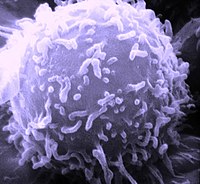
Photo from wikipedia
Background The diversity of the B cell immune repertoire may drive humoral injury and rejection in organ transplantation (tx). Methods We utilized advances in next-generation sequencing of B cells and… Click to show full abstract
Background The diversity of the B cell immune repertoire may drive humoral injury and rejection in organ transplantation (tx). Methods We utilized advances in next-generation sequencing of B cells and custom computational pipelines to study functionally correlated variations in the VDJ and CDR3 regions, examining 124 DNA and RNA samples from the same tx patient over serial times before tx, and at 6 and 24 mo post-tx. Each blood sample was paired with a kidney tx bx scored by progressive changes in the chronic allograft damage index (CADI) over time. Three patient groups sorted into non-progressors (NP), progressors/ no rejection (PNR) and progressors/ with rejection (PR). The immune repertorie was studied by (1) analyzing diversity measures (richness and entropy) longitudinally using linear-mixed effect model and (2) performing network analysis to characterize clonal expansion. We have defined a network for each sample where each vertex in the network represents a B-cell sequence where the size is defined by all the identical sequences. Edges are calculated using the clone definition (same V and J segments, same CDR3 length and 90% nucleotide identity between CDR3s) and clusters represents each clone in the repertoire. Gini index is calculated for vertex size and cluster size distribution. Results Pre-tx immune repertoire diversity was significantly greater in patients that went on to reject their tx (PR vs NP, p = 0.008). Post-tx, there was a strong interaction between clinical outcome (CADI score, AR) and time, with a significant reduction in clonal diversity (p = 0.05) in PR, and an increase in NP, combined with relevant changes in the Gini index applied to vertex size and cluster size from the network analysis at 24 mo post tx (PR vs. NP, p=0.003 and p=0.001). Dominant clones persisted/ further expanded in PR patients over time. Conclusions The diversity of recipient B cell immune repertoire plays a major role in driving AR and progressive chronic tissue injury, and this effect can be observed even prior to engraftment of the tx organ. Selected dominant clones expand in patients who reject allografts, and the preservation of these dominant clones results in a reduction in of their overall repertoire diversity. Pre-tx prediction of recipient risk of rejection, irrespective of the donor organ, provides a powerful approach for precision medicine in organ tx.
Journal Title: Transplantation
Year Published: 2018
Link to full text (if available)
Share on Social Media: Sign Up to like & get
recommendations!